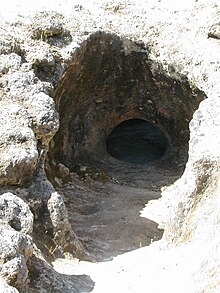Rock-domed tombs of Palmela
The rock-domed tombs of Palmela (also called Casal do Pardo or Quinta do Anjo) in Portugal are located about 200 m southeast of the church of Aldeia de Cima in a suburb of Quinta do Anjo in the Região de Lisboa .
Rock- dome graves (Portuguese: Grutas artificiais) are dome-shaped collective graves with a corridor , which are imitations of the rock graves carved out of natural rock . They were in use on the Iberian Peninsula during the transition from the Copper to the Bronze Age .
description
At Palmela there are four differently oriented rock dome tombs in a row on the edge of the rock. It is unknown when the graves were discovered or first examined. An excavation took place between 1876 and 1878 under the direction of "C. Ribeiro". In 1906 "AJ Marques da Costa" carried out excavations in which mainly the corridors were examined. The graves are similar to those of Alapraia , but some are better preserved. A passage leads to a bubble-shaped antechamber and from there to the main chamber, which is more or less round in plan. The rooms are carved out of the existing limestone. The chambers are dome-like rooms, which usually have a round hole in the middle that was originally closed with a large stone slab.
Gruta 1
When excavated in 1906, grave 1 (Gruta 1) had a total length of 9.75 m, the diameter of the oval chamber is 5.5 m (lengthways) and 4.7 m (crosswise). The height of the center of the dome is 2.3 m.
Gruta 2
Grave 2 (Gruta 2) was 11.5 m long at the time of excavation. The diameter of the almost round chamber is 4.5 m (lengthways) and 4.6 m (across). The height of the center of the dome is 2.0 m.
Gruta 3
Grave 3 (Gruta 3) is disturbed by an older quarry and was preserved up to a total length of about 9.0 m. The diameter of the burial chamber is 5.0 m in the longitudinal axis and 5.3 m in the transverse axis. A height of around 2.5 m can be estimated for the former center of the dome.
Gruta 4
Grave 4 (Gruta 4) is the worst preserved, the passage and part of the antechamber have been destroyed. The diameter of the chamber is 4.1 m (lengthways) and 4.7 m (across).
The graves are characterized by rich grave inventories. In addition to finds from the older ones, the finds from the later Copper Age with ceramics from the bell beaker culture predominate , including larger bowls with thickened, ornate edges, which are known as Palmela bowls. Palmela points, a form that occurs throughout the Iberian Peninsula in the Younger Copper Age, are copper lance heads or larger arrowheads in the shape of bay leaves, which were discovered here for the first time.
The finds from the dome tombs are in museums in Lisbon . Other important sites are Alapraia in Portugal and Alcaide in Spain .
literature
- Vera Leisner , Georges Zbyszewski, Octavio da Veiga Ferreira: Les Grottes artificielles de Casal do Pardo (Palmela) et al culture du vase campaniforme. (1961) Memórias das Serviços Geológicos de Portugal NS 8
- Thomas G. Schattner (Ed.): Archaeological guide through Portugal (= cultural history of the ancient world . Vol. 74). Philipp von Zabern, Mainz 1998, ISBN 3-8053-2313-1 p. 153
Individual evidence
- ↑ a b c d e f Archaeological guide through Portugal . In: Thomas G. Schattner (Ed.): Cultural history of the ancient world . tape 74 . Philipp von Zabern, Mainz 1998, ISBN 3-8053-2313-1 , p. 153 f .
Web links
Coordinates: 38 ° 33 ′ 50.5 ″ N , 8 ° 56 ′ 19.5 ″ W.
